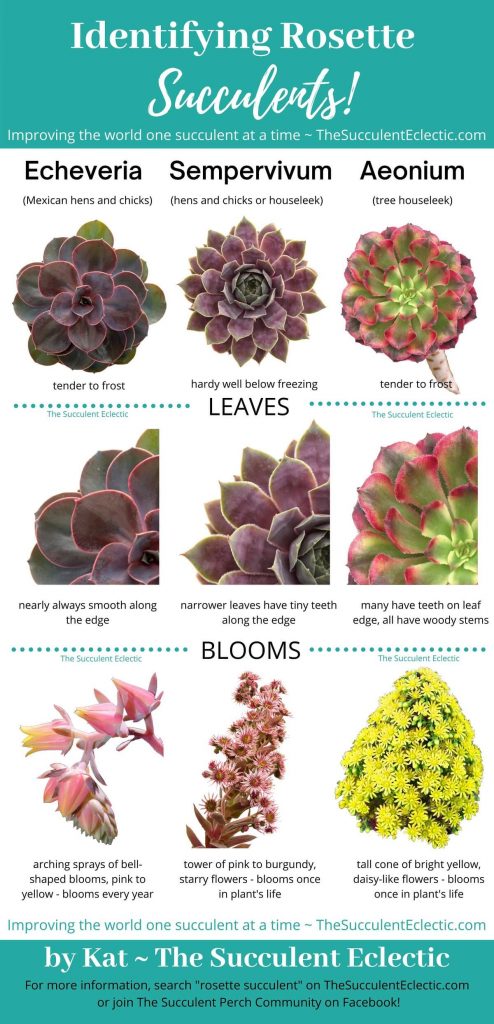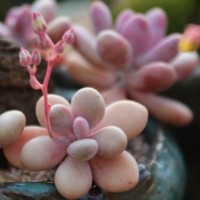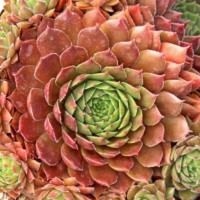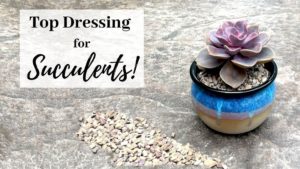I am convinced that one of the many (many) reasons succulents are so popular is that so many varieties look like flowers. These rosette succulent plants give instant and lasting satisfaction. Rather than care for boring-looking foliage plants for months or even years, waiting for 2 weeks of blooms, succulent-lovers can enjoy the look of flowers all year round. Rosette succulent types are particularly popular with wedding planners and succulent crafters. Rosettes star in succulent bouquets and many other succulent DIYs. Let’s take a closer look at rosette succulent varieties, their uses and how to tell them apart.
What is a Rosette Succulent?
In this Post We'll Cover:
{Please note, some links in this post may be affiliate links to sites that pay me a small commission if you click on the link and make a purchase. This commission is at absolutely no cost to you. I only recommend products and companies that I have worked with and truly love! ~Kat}

So, just what is a rosette and why are there so many varieties of rosette succulents? A rosette plant is one whose leaves are arranged in concentric circles around a common center, looking like a rose. The rosette form optimizes each leaf’s exposure to sunlight, while also funneling captured moisture to the center of the root zone. While most rosette succulent types hug the soil, some form rosettes at the end of lengthening, curling, woody stems.
Many succulents form rosettes, including Aeonium, Agave, Aloe, Echeveria, Graptopetalum, Orostachys and Sempervivum. Even some Crassula and Sedum varieties have a rosette form.
While each of these rosette succulent types includes a wide range of shapes, colors and textures, it can be difficult to tell them apart. And succulent identification can be very important. Some rosette succulents are safe for pets and small children, while others are toxic. Some rosette succulent varieties like Sempervivum and Orostachys are quite cold hardy, while others are killed by frost. When you are getting your succulents ready for winter, you need to know which need protection. So — how to recognize different varieties?
Rosette Succulent Identification

As is often the case, successful rosette succulent identification comes down to the details. Some details, like succulent flowers, are not apparent most of the time, but others can be seen immediately. Look for details like:
- leaf shape and thickness
- size
- color
- type and size of stem
- markings or bumps
- presence or absence of ciliate hairsCiliate (SILL-ee-uht) hairs are a fringe of tiny hairs along... More
- presence or absence of leaf windowsLeaf windows are specialized leaf structures specific to som... More
- presence or absence of epicuticular wax
- spikes, spines or smooth leaves
- growing conditions where the plant thrives
Some of the distinguishing characteristics are certain and straightforward. For instance, Aeonium always form on upright, woody stems. Other characteristics can only be determined relative to other plants. For instance, Sempervivum leaves are typically more narrow that those of Echeveria or Aeonium. Get to know the characteristics of each variety to help you to identify new plants you will meet.
Identifying Characteristics of Rosette Succulent Types

These are some of the primary characteristics of the main groups of rosette succulent genera that will help you to recognize and identify them (see the end of the post for images!)
Aeonium – All Aeonium have sturdy, upward-growing woody stems with the rosette at the tip. No true offsetsSucculent offsets are the baby succulents that form at the b..., instead, the stem branches, forming a new rosette. Many varieties have ciliate hairs all along each leaf margin. Monocarpic, each rosette eventually forms a bright yellow cone of tiny, daisy-like flowers. Aeonium leaves bruise easily when handled roughly. Even wind-driven debris will cause brown marks on the leaves.
Agave – Agave rosettes reach 1-20 feet in diameter, with long, sharp spines at the terminal point of each leaf, and often along their leaf margins. They have little or no stem. MonocarpicMonocarpic (Mon-oh-CAR-pic) plants are those that flower, se..., Agave flowers are extraordinarily tall and showy, occurring after years of growth.
Aloe – Aloe rosettes frequently have spines along the edge of their leaves and/or display intricate mottling on the surface of the leaves. The leaves come to long points. With little to no stem, Aloe plants form large, tight clusters of multiple offset rosettes. Blooms are formed by many slim, tubes held aloft on tall, straight stems.
Echeveria – a broad genus of rosette succulents with many colors and forms. Mature Echeveria rosettes range from 2-18 inches across. Most have little to no stem. Nearly all have smooth leaf margins with no ciliate hairs. Tall stems arch, with several lantern-like blooms in yellow, orange or pink.
Graptopetalum – Graptopetalum look a great deal like Echeveria, but each rosette forms at the tip of a curling, pendulous, semi-woody stem. The leaf margins are always smooth. Small stems produce a spray of starry blooms.
Orostachys – Orostachys are cold-hardy succulents that form rosettes ranging from silver to green. With little to no stem, this is a very low-growing plant, typically no more that 3 inches tall. Monocarpic, they form conical blooms. Offsets are connected to the mother rosette by a stolonA stolon (STOLE-ehn) is a horizontal root, growing just abov....
Sempervivum – Exceptionally cold hardy, Sempervivum form rosettes in a wide range of colors that can change dramatically with the seasons. They have no stems, but all have ciliate hairs along the leaf margins. Offsets are attached to the mother rosette by a stolon. Monocarpic, tall bloom stems form with starry blooms at the top.
Choosing Rosette Succulents

Selecting succulents to suit their site is an important factor to ensure success with your succulents. Choose rosette succulent types to suit your intended use. For instance, in a tightly-planted succulent dish garden, rosette succulents with little or no stem will stay close to the arrangement as they grow. Echeveria, Aloe, Sempervivum, Orostachys and small Agave are great choices. Aeonium and Graptopetalum and its hybrids will form ever-lengthening stems that will soon carry the rosettes far from the rest of the succulents in the arrangement.
Agave make handsome, individual statement plants in the landscape. Aeonium will form clusters of rosettes that can reach 3 feet tall when grown in the ground in mild climates. Graptopetalum stems first grow up, then arch over and hang down, making for striking hanging baskets.
Sempervivum and Orostachys are ideal ground cover succulents, especially for cold climates. Aloe and Echeveria work well as ground cover in mild climates. Echeveria, the classic rosette succulent, stars in succulent arrangements and succulent bouquets.
Where to Find Rosette Succulents?

Rosette succulent types are among the most popular varieties to be found. Local nurseries, farmer’s markets and even box stores carry an assortment of rosette succulents. The selection is a bit limited, but these are easy to grow and are often in good condition.
My go-to source for the largest selection of rosette succulents is Mountain Crest Gardens. They offer an exceptional range of Echeveria and Sempervivum in particular, with a good assortment of Aeonium, Agave, Aloe, even a few Orostachys. They also carry Graptopetalum and its hybrids. You’ll find a great mix and good savings in the rosette cuttings. Leaf & Clay is another source for exceptional quality and some hard-to-find rosette succulents.
Never overlook the potential for sharing with other gardeners in your area, whether you know them or not! Admiration for their succulents is a great ice breaker, and when it’s time to prune and refresh plants is a great time to give and share succulent cuttings. Or why not join a Succulent Share in my Facebook group for succulent-lovers? We’d love to have you join us!
Succulent Rosette Identification Infographic
The most common (and most commonly confused) rosette succulent types are Echeveria, Sempervivum and Aeonium. I have created this infographic to help you recognize the differences between them!

Rosette Succulent Types
If you have any questions about rosette succulents, please take a moment and leave me a comment. I’ll get right back to you!
’til next time…
Happy Gardening!

P.S. For more great succulent information, please subscribe to The Succulent Eclectic and you’re get my FREE e-course 7 Steps to Succulent Success! Thanks!
P.P.S. Why not join my Facebook Group for succulent lovers? We talk about succulent care, propagation, succulent identification, and design. It’s a warm and welcoming group that would love to meet you!

![You are currently viewing Rosette Succulent Types ~ Identification & [Infographic]](https://thesucculenteclectic.com/wp-content/uploads/2020/10/Recognizing-Different-rosette-succulent-types.jpg)















I just identified a succulent that I saw at my local roadside stand. It was planted in an old pair of boots and growing beautifully. I have a pair of old work boots that my husband wore and it is screwed into a decorative chair that stays out all year. I live in Pennsylvania. The succulent is a Rosette Bloom….. Aeonium. My question is if I plant it in the boots can it stay outside in all weather?
Thank You
Hi Nancy,
What a charming display that would be! However, an Aeonium would never survive your winters. However, Sempervivum would do so very well — and it’s also a rosette form succulent!
I would love to see a photo when you do this!
~Kat